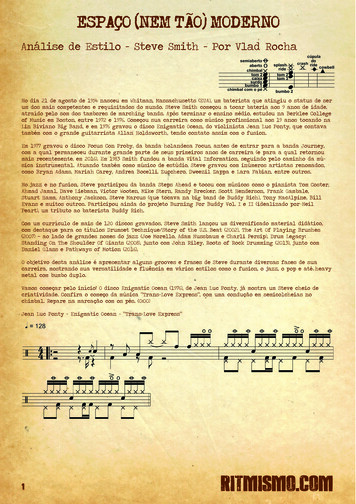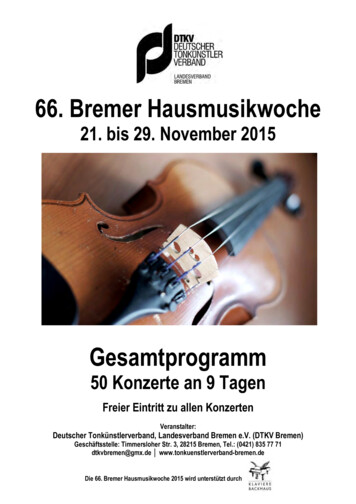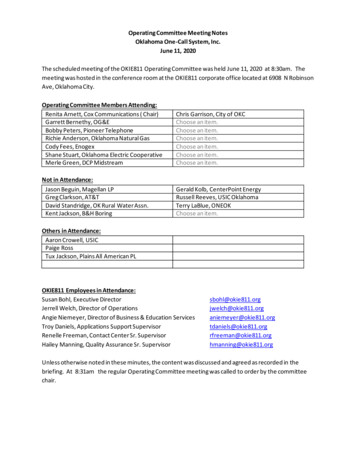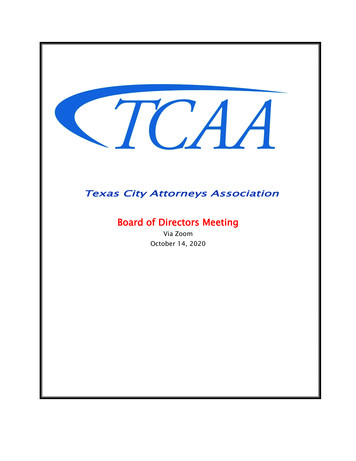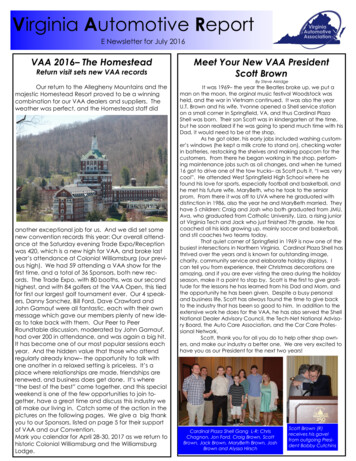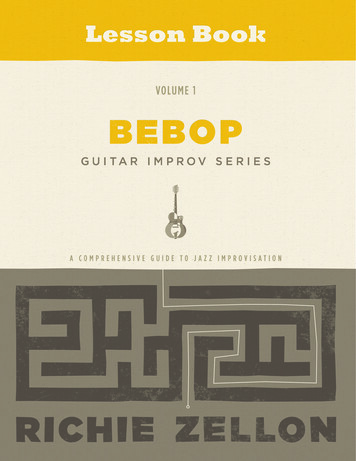
Transcription
BEBOPGUITAR IMPROV SERIESVOLUME 1Lesson Bookv4.0RICHIE ZELLONCover Design by Robert Stralka 2014 Richie Zellon. All Rights Reserved.Band in a Box is the registered trademark of PG Music Inc.No parts of this publication, except where explicitly noted, may be reproduced or transmitted, in any form or byany means, digital, mechanical, photocopying, recording, or otherwise, without prior written permission of theauthor. Unauthorized uses are an infringement of the U.S. Copyright Act and are punishable by law.
about the bebop guitar improv seriesDeveloped over a 10 year period by its author and used as an instructional method in various music schools, TheBebop Guitar Improv Series consists of two volumes with multi-media materials. It is intended as a guide to leadboth the player with little or no formal improvisation skills, as well as the player who does so exclusively by ear,on the journey to becoming a seasoned jazz improviser. Each volume is comprised of 3 books: the Lesson Book,Workbook, and Scale & Arpeggio Book.Volume 1 is devoted to teaching the rudimentary principles of jazz improvisation in theory and practice. Itinitially focuses on learning how to systematically develop a vocabulary to improvise over chord changes froma guitar-oriented technical perspective. A variety of essential harmonic progressions found in jazz are coveredin order of difficulty. Each new progression is taught through a series of short etudes, and gradually introducesone or more of the chord/scales required to improvise over most jazz standards. Various melodic concepts andsyncopated rhythms commonly used in the swing/bebop idioms, are covered as well.Volume 2 builds on the principles explored in Volume 1 and explores various applications over «Rhythm Changes»,as well as standards based on major, minor and extended tonalities. The technical focus is on multi-positionalplaying using the entire fretboard.Be sure to check out the Bebop Guitar Improv Series Online! Featuring 150 instructional videos, it is theperfect compliment to the book series.For more info please visit https://bebopguitar.richiezellon.comNOTE: This series focuses solely on the development of linear improvisation. A working knowledge of basic 7thchords is presumed throughout, as guitar oriented instruction on their construction is beyond its scope.
about the authorRichie Zellon, guitarist, composer, and music educator, has held teaching positions as professor of jazz guitar atFlorida International University (Miami) the University of South Florida (Tampa) The Music Workshop (Orlando)and his own venue, Miami Jazz Guitar.With several critically acclaimed recordings under his name, Zellon has recorded and performed with some ofthe most influential musicians both in the mainstream and Latin jazz genres. Among them, Paquito D’ Rivera,David Leibman, Jerry Bergonzi, Sam Rivers, George Garzone, Danilo Perez, Edward Simon, Jeff Berlin, AbrahamLaboriel, Oscar Stagnaro, Alex Acuna and Ignacio Berroa to name a few.Due to his innovations in the field of jazz and latin music he has been profiledin several important books such as «The Great Jazz Guitarists» by ScottYanow, «The Jazz Guitar: Its Evolution, Players and Personalities Since 1900»by Maurice J. Summerfield, «El Diccionario de Latin Jazz» by Nat Chediak,«Caliente: A History of Latin Jazz» by Luc Delanoy and «Jazz Jews» by MichaelGerber.For almost a decade, he wrote an instructional column for Jazz Improv magazine. In addition to his dedication to mainstream jazz, his ongoing research on the music of various LatinAmerican cultures and their fusion with contemporary music has been a sought after topic by musicians atinternational clinics and workshops as well.For more information please visit www.richiezellon.com
BEBOP GUITAR IMPROV SERIES . VOLUME 1lesson bookintroductionw hy«b e b o p » i m p r o v i s at i o n ?Some guitarists might ask, why specifically study «bebop» improvisation? For me the answer started tounfold one night back in 1974 at the Keystone Korner, a small jazz club in San Francisco. Between sets Iwent and sat at the bar next to the featured guitarist. After introducing myself and expressing my admiration for his music, I went on to explain that I had just started studying music at a nearby school and I would verymuch appreciate his advice on a concerning matter. After he agreed to do so, I shared my confusion regardinghow to approach the study of jazz improvisation on guitar. He listened patiently and then replied with a smile,«It’s simple, just start by breaking down every chord and playing it as an arpeggio». Although it didn’t make muchsense at the time, I felt I should pay special attention to this seasoned jazz guitarist’s advice. His name by the waywas George Benson.A few years passed and in 1977 I found myself in Boston, half way through my first semester at the Berklee College of Music. Although the harmony and arranging classes were definitely useful, the 30min weekly instructionI received on my instrument left much to be desired. Being told to «use the dorian mode over a II-7 in a majorkey», or «the mixolydian mode over the V7», wasn’t necessarily teaching me how to come up with any lines inthe style of my favorite bebop guitarists. My solos still sounded as if I were just running scales. Sound familiar?One evening as the semester was coming to an end, I went down to the «Jazz Workshop», a small club on BoylstonStreet. It so happened that one of my favorite jazz guitarists was booked there all week. I am referring to PatMartino, whom I mustered the courage to approach at the end of the night and beg for private lessons. Martinoagreed and summoned me to meet him the next day at a nearby motel where he was staying. It was during thiseye opening lesson that my understanding of how the guitar’s fretboard is organized, was first revealed. Martinounraveled the mystery of how any arpeggio could be extended and fingered throughout the entire fretboard ina seamless fashion. Finally, I was ready to begin systematically practicing Mr. Benson’s past advice regarding thebreaking down of 7th chords into arpeggios! I still however, except occasionally by ear, did not quite understandhow to come up with those beautiful flowing lines «a la Wes».It wasn’t until after graduating from Berklee and pursuing private studies with jazz guru, Charlie Banacos, that Ifinally understood the connection between bebop and the broken chord arpeggio concept to its fullest. Banacos,who spent the last years of his life as director of jazz studies at the New England Conservatory, observed that alarge percentage of the bebop language is based on a vertical approach to improvisation. It consists of arpeggiatedchords with various diatonic or chromatic note approaches to its root, third, fifth, and seventh tones.4
INTRODUCTIONUpon moving to Florida in the early 90’s, I received more insight into this concept. This first occurred duringmy private studies with trumpeter Red Rodney, once a member of the Charlie Parker Quintet. Listening to himin his Boyton Beach home, improvise and explain how the bebop players did it, was like hearing it straight fromthe horse’s mouth! He reinforced the fact that Bird and the rest of his contemporaries were not thinking so much«horizontally», that is in terms of scales, but instead «vertically» using various approach note permutations to thechord tones. During this period, I also had the opportunity to play some gigs with legendary saxophonist SamRivers who had recently moved to Orlando. Rivers who belongs to a later generation than Rodney, is associatedwith further developments in the evolution of jazz, such as the «avant garde» and «modal jazz» movements. However, upon listening to Rivers improvise over a standard, in spite of occasional angular lines and extended use oftonality, the architecture of his solos was for the most part, straight out of the bebop tradition! This holds truefor the majority of post-bop jazz musicians. So if you’re still wondering, «why bebop?» — it is safe to concludethat mainstream jazz improvisation as we know it today still has its foundation in the various concepts pioneeredduring the bebop era . Consequently in the present world of music academia, most institutions featuring a jazzcurriculum agree that a solid understanding of these concepts is a prerequisite for the aspiring improvisor.In the previous paragraphs I have introduced you to my most esteemed mentors and tried to convey in a nutshell,my personal journey in learning jazz improvisation. It is with great pride and joy that through this series of books,I pass on to you what I believe is the essence of the bebop idiom as applied to the guitar. The information containedherein represents the sum of my experience teaching this art for several decades to hundreds of guitarists, bothprivately as well as in various universities.The Bebop Guitar Improv Series comprises two volumes. Throughout this first volume I will be using the bluestonality as the primary vehicle to teach the rudimentary principles of jazz improvisation. Four varieties of 12 barblues are covered in order of difficulty: 1. Traditional Blues, 2. Jazz Blues, 3. Minor Blues, and 4. Bird Blues. Eachnew progression introduces one or more of the required chord/scales to eventually improvise over most jazzstandards.In Volume 2, I will expand on the information provided here and explore various applications over «RhythmChanges» as well as major, minor and extended tonalities. In regards to this first volume, the reason I have chosenthe blues in contrast to the conventionally used major tonality, is 3-fold in its nature:5
BEBOP GUITAR IMPROV SERIES . VOLUME 1lesson book1. h a r m o n i c s i m p l i c i t yIn order to improvise over any typical standard out of «The Great American Songbook», a good command of atleast 7 chord families and their associated scales is usually the prerequisite. This is due to the fact that any diatonicmajor or minor tonality is comprised of 7 different chords and scales. The blues on the other hand, is like a minitonality that when performing over its traditional harmonic structure (I7-IV7-V7), requires the use of only onescale and one chord type. This enables the student to learn the rudiments of melodic improvisation and applythem to a musical progression at a much quicker pace than if he first had to learn 7 different scales and chordtypes. It can be an over-whelming experience for many, often resulting in discouragement from pursuing therequired study to improvise over a typical major/minor based jazz standard.Although still possessing a degree of difficulty, the feat of learning to improvise is greatly simplified when startingout with just one scale. Once mastered, additional scales are gradually introduced by changing just one noteto the already familiar one. NOTE: Even the so called architects of bebop– Charlie Parker, Dizzy Gillespie,and Thelonious Monk–are known to first have mastered applying the new concepts over blues changes beforeattempting to incorporate them over more complex harmonies.2 . s t r u c t u r a l e co n o m yUnlike most jazz standards which have a 32 bar structure, the blues form as stated is traditionally comprised of a12 bar structure. It is obviously easier for the beginning improviser to memorize and thus melodically «navigate»over a 12 bar progression without getting lost, rather than over a full fledged 32 bar piece.3 . e v o lu t i o n a ry n at u r eLast but not least, the blues is a predominant influence of the jazz idiom, especially in its early development. Itsrhythmic essence gave birth to the «swing feel» which also helped define mainstream jazz. Its harmonic structurehas also gradually evolved throughout jazz history to include all the current developments of each era. Just listento a recording of Sidney Bechet playing the blues and compare it to one by John Coltrane doing the same severaldecades later, and this will become evident. Consequently, I have chosen to mirror this evolution to begin ourstudy of improvisation.6
INTRODUCTIONs o m e i m p o r ta n t f i n a l a d v i c e .I am a firm believer in the concept that jazz improvisation is a language and should be learned and taught as such.Consequently, to become a fluent conversationalist in any language you have to first understand its grammatical components in order to properly diagram a sentence. Yes, it’s true that languages can and should initially belearned by ear, as we naturally do in the early stages of life. However, we will remain at a primitive level of communication if we do not eventually pursue an education. The same holds true in the case of such a sophisticatedmusical language as jazz. It is one thing to improvise over traditional blues using just 1 pentatonic scale, but adifferent matter altogether, when it comes to doing so over a 32 measure progression with a dozen moving chords!We are fortunate to live in a day and age in which the grammar of jazz has evolved and been codified into a teachable language. On the unfortunate side, we also happen to be living in a time when «attention deficit disorder»seems to run rampant in our society and people no longer have the patience to pursue any task that is going torequire a long term focus and commitment—that is, unless there is a chance they will be generously compensated down the road. Sadly, this is usually not the case with most art forms. As a result, the internet is filled withbooks and videos that claim to teach you the «lite and quick» approach to jazz improvisation. This is usually donethrough a compilation of random riffs and licks, which in spite of providing instant gratification in the form of«fragmented music», fail to bestow the necessary foundation the student requires to evolve into a fluent soloist.So, what am I trying to convey through all of this? Simply that there is no short cut to playing jazz! A brief lookinto any biography of say—Bird, Miles, Trane, Wes, etc.—will reveal that these legends who are no longer with usspent years studying and practicing this «language», as have all its successful present day practitioners.In conclusion, any guitarist who is serious about learning to improvise in the jazz idiom should first be aware ofthe fact that doing so is not a short term commitment. To this effect, please keep in mind that jazz represents thehighest pinnacle in the art of improvisation, and can provide you with an ongoing means of creative expressionfor the rest of your days! Try to savor and enjoy each step of the learning process, and don’t worry about the next stepuntil you’re actually taking it. The adoption of this mindset is crucial if you want to make progress on this journey.Take your time! Jazz is a lifetime pursuit.Best Wishes,Richie Zellon7
CONTENTSlesson 1 : fundamentalsHow To Use This Lesson Book .p 12A Brief Introduction To Tonality.p 13Common Types Of Harmonic Cadences.p 14Blues Tonality.p 15Introducing Mixolydian Fingering Patterns 1, 4 & 5.p 17Guide Tones & Voice Leading.p 18Introducing Intervallic Script.p 20lesson 2 : using passing & neighboring tonesHarmonic & Non-Harmonic Tones.p 22Introducing Approach Tones.p 22Anatomy of a Be-Bop Line.p 23Passing Tones & Neighboring Tones.p 24Summary of Mixolydian Passing & Neighboring Tones.p 25How to Practice the Jazz Etudes.p 26Etude 1: Blues using Neighboring Tones-Variation 1.p 28Etude 2: Blues using Neighboring Tones-Variation 2.p 29Etude 3: Blues using Neighboring & Passing Tones-Variation 1.p 30Quiz #1.p 31How To Write An Etude Using The Rhythm Templates.p 32Rhythm Template #1.p 35Rhythm Template #2.p 37Etude 4: Blues using Neighboring & Passing Tones-Variation 2.p 39Etude 5: Blues using Neighboring & Passing Tones-Variation 3.p 40Rhythm Template #3.p 41Rhythm Template #4.p 43lesson 3 : using unprepared approaches & enclosuresAvoiding Modal Ambiguity.p 46Harmonic Anticipations.p 46Introducing Unprepared Approaches & 2 Note Enclosures.p 47Summary of Mixolydian Unprepared Approaches.p 48Etude 6: Blues using Unprepared Approaches-Variation 1.p 51Etude 7: Blues using Unprepared Approaches-Variation 2.p 52Etude 8: Blues using Unprepared Approaches-Variation 3.p 53Quiz #2.p 54Rhythm Template #5.p 55Rhythm Template #6.p 578
lesson 4 : using upper extensionsIntroducing Upper Extensions.p 59Tips on Using Upper Extensions Effectively.p 60Should I Call it an Upper Extension or an Approach Note?.p 61Etude 9: Blues using Upper Extensions-Variation 1.p 62Etude 10: Blues using Upper Extensions-Variation 2.p 63Quiz #3.p 64Rhythm Template #7.p 65Rhythm Template #8.p 67lesson 5 : using double chromatic approachesIntroducing the II-7 and IV-7 Chords.p 69Using II-V-I Cadences.p 69Introducing Double Chromatic Approaches.p 70Etude 11: Blues using the II-7 & IV-7 w/ Double Chromatic Approaches-Variation 1.p 71Etude 12: Blues using the II-7 & IV-7 w/ Double Chromatic Approaches-Variation 2.p 72Etude 13: Blues using the II-7 & IV-7 w/ Double Chromatic Approaches-Variation 3.p 73Quiz #4.p 74Rhythm Template # 9.p 75Rhythm Template #10.p 77lesson 6 : using 3 note enclosuresIntroducing 3 Note Enclosures.p 79Introducing Secondary Dominants.p 80Introducing the V7 Altered Chord.p 81Etude 14: Blues using Secondary Doms & 3 Note Enclosures-Variation 1.p 82Etude 15: Blues using Secondary Doms & 3 Note Enclosures-Variation 2.p 83Etude 16: Blues using Secondary Doms & 3 Note Enclosures-Variation 3.p 84Quiz #5.p 85Rhythm Template #11.p 86Rhythm Template #12.p 88lesson 7 : using 4 note enclosuresIntroducing 4 Note Enclosures.p 90Introducing Minor Blues & Minor II-V-I Cadence.p 90Etude 17: Minor Blues using 4 Note Enclosures-Variation 1.p 92Etude 18: Minor Blues using 4 Note Enclosures-Variation 2.p 93Etude 19: Minor Blues using 4 Note Enclosures-Variation 3.p 94Quiz #6.p 95Rhythm Template #13.p 96Rhythm Template #14.p 989
lesson 8 : exploring new fingering modelsIntroducing the Pattern 4 Fingering Model. p 100Etude 20: Blues using Upper Extensions & Various Approaches. p 101Etude 21: Blues using the II-7 & IV-7 Chords. p 102Etude 22: Blues using Altered Dominant Chords. p 103Etude 23: Minor Blues. p 104Rhythm Template Assignments for Lesson 8. p 105lesson 9 : bird bluesIntroducing «The Pattern 5 Fingering Model» & «Overlapping Pattern Shifts». p 107Bird Blues. p 107Harmonic Analysis: The VI-7 chord / Secondary II-V’s. p 108Harmonic Analysis: Dominant Chains & The Tritone Substitution Principle. p 109Harmonic Analysis: Interpolated Minor II Chords. p 110Etude 24: Bird Blues-Variation 1. p 112Etude 25: Bird Blues-Variation 2. p 113Etude 26: Bird Blues-Variation 3. p 114Etude 27: Bird Blues-Variation 4. p 115Quiz #7. p 116appendix : assignment checklist .p 11710
LESSON 1f u n d a m e n ta l s11
BEBOP GUITAR IMPROV SERIES . VOLUME 1lesson bookhow to use this lesson bookThe Bebop Guitar Improv Series - Lesson Book , was designed to be used in conjunction with 2 companionbooks: Workbook and Scale/Arpeggio Fingerings . The series consists of 5 key sections which as a wholeexplore the different areas required to develop an improvisational vocabulary in the bebop idiom. Here is abrief description of each one, and in which book they can be found:The Jazz Etudes (The Bebop Guitar Improv Series: Lesson Book) The etudes, written in both regularnotation and tab, are the heart and soul of this method. They serve as models to train the aspiringimproviser in utilizing the melodic techniques and rhythms taught in each lesson. They are presentedin order of gradual difficulty. For more info see p.26. Band in a Box & MP3 files of all the etudes areavailable for download online. If you have purchased this book you can find the URL on p. 34.The Scale / Arpeggio Fingerings (The Bebop Guitar Improv Series: Scale & Arpeggio Fingerings). Thescales and arpeggio patterns provide the necessary fingerings to properly play all the etudes in the LessonBook as well as the technical exercises contained in the Workbook.The Bebop Calisthenics (The Bebop Guitar Improv Series: Workbook). These exercises are carefullystructured to work simultaneously at many levels to aid in the development of technical skill, knowledgeof the fretboard, reinforce the use of various linear melodic concepts introduced, create an ear-fingerconnection, and overall help your improvisational skills flourish. For more info see p.15 in the workbook.The Rhythm Lab (The Bebop Guitar Improv Series: Workbook). This segment of the lessons, willintroduce you to the various rhythmic figures that are commonly em
The Bebop Guitar ImprovSeries comprises two volumes. Throughout this first volume I will be using the blues tonality as the primary vehicle to teach the rudimentary principles of jazz improvisation. Four varieties of 12 bar blues are covered in order of difficulty: 1. Traditional Blues, 2. Jazz Blues, 3. Minor Blues, and 4. Bird Blues.
